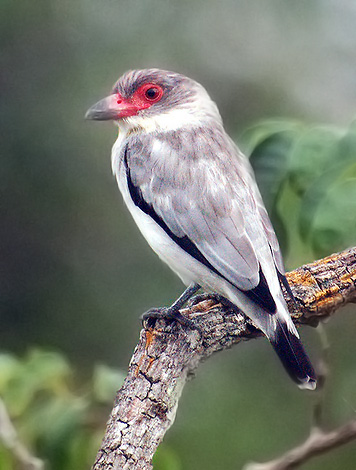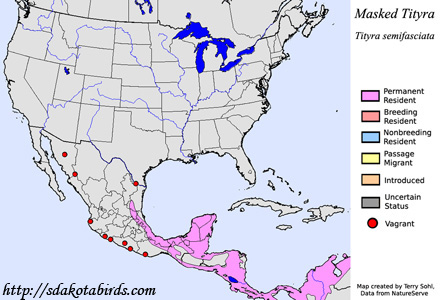| Length: 8 inches | Wingspan: 15 inches | Seasonality: Non-resident in South Dakota |
| ID Keys: Obvious red eye-ring and base of bill, gray upperparts, white underparts, grey head on female, black head on male | ||
 The
Masked Tityra is only a vagrant to the United States, as their normal range
is in central to southern Mexico, Central America, and parts of northern
South America. They have only been found within the United States on one
occasion (at the time of this writing), when a lone bird was found in
Bentsen Rio Grande State Park in Texas, in 1990.
The
Masked Tityra is only a vagrant to the United States, as their normal range
is in central to southern Mexico, Central America, and parts of northern
South America. They have only been found within the United States on one
occasion (at the time of this writing), when a lone bird was found in
Bentsen Rio Grande State Park in Texas, in 1990.
Habitat: Found in a variety of forested settings, but they can also be found near forest clearings and edges, second-growth forest, plantation forest, and agricultural lands.
Diet: Feeds heavily on fruits and berries, but will also consume insects, particularly during the breeding season when insects are fed to the young.
Behavior: Often forages by perching conspicuously on a tree branch, sallying out to snag insects that it spots. Will also clamber through foliage for fruits and berries.
Nesting: The nest of a Masked Tityra is a tree cavity, often a cavity that used to be a woodpecker nest. The female typically lays 2 eggs and she alone incubates them. Both parents feed the young once they hatch. Young fledge after about 3 weeks.
Song: The song is a squeaky chet-chet-chet, as well as a buzzy zrrt-zrrrt-zrrrt
Migration: They are considered permanent residents throughout their normal range, but short-distance movements are noted in response to availability of fruit and other food items.
Interactive eBird map: Click here to access an interactive eBird map of Masked Tityra sightings
Similar Species: Black-tailed Tityra (Not found in the United States)
Conservation Status: Populations are likely decreasing, but they are still found throughout a wide geographic region and are not currently a major conservation concern. The IUCN lists the Masked Tityra as a species of "Least Concern".
Further Information: 1) Birdlife International - Masked Tityra
2) Cornell's Neotropical Birds - Masked Tityra
3) Beauty of Birds - Masked Tityra
Photo Information: Photo by Zemlinkl - Photo licensed under Creative Commons Attribution 2.0 Generic license
| Click below for a higher-resolution map |
 |
| South Dakota Status: Non-resident in South Dakota |
Additional Masked Tityra Photos (coming soon!!)
